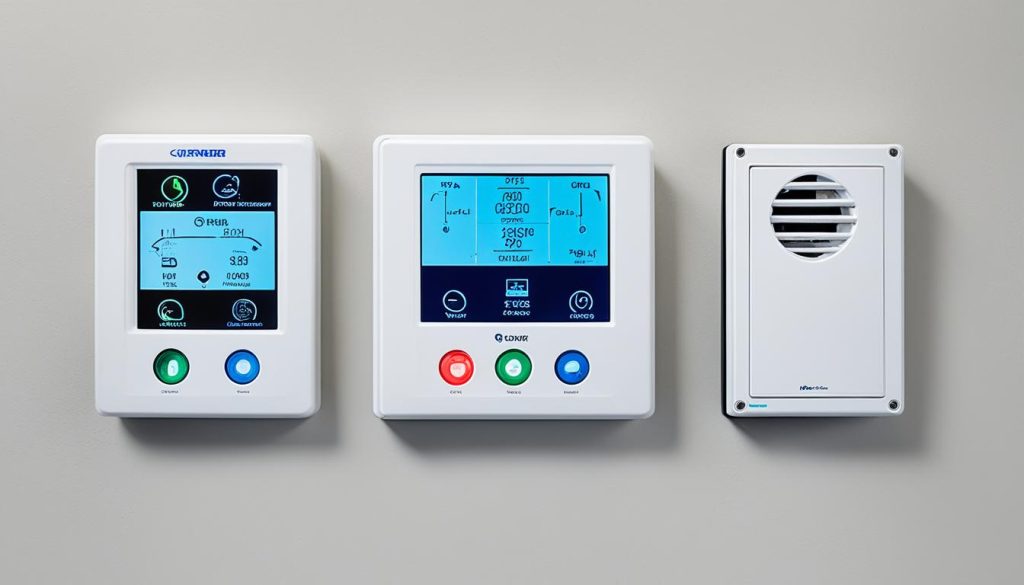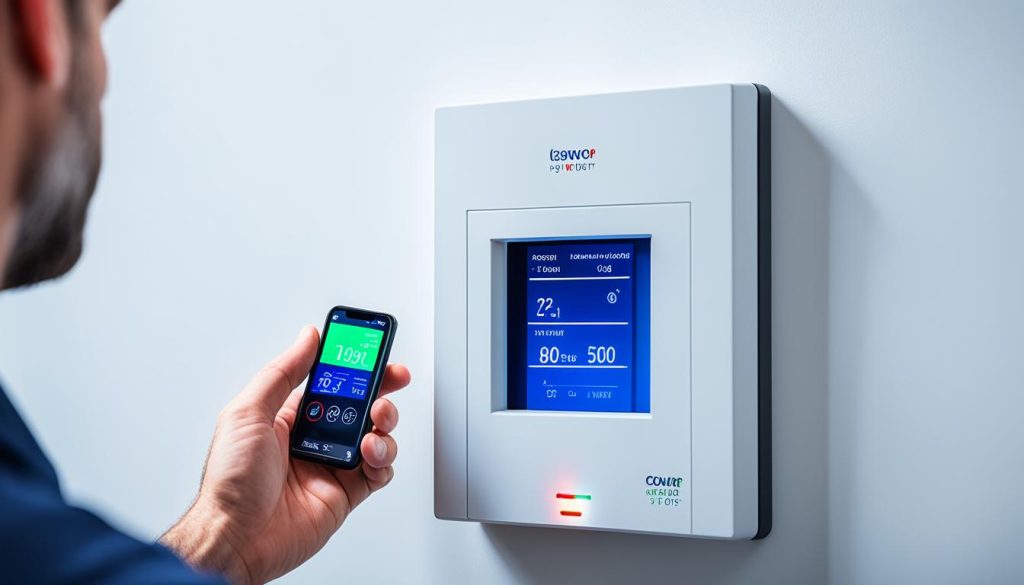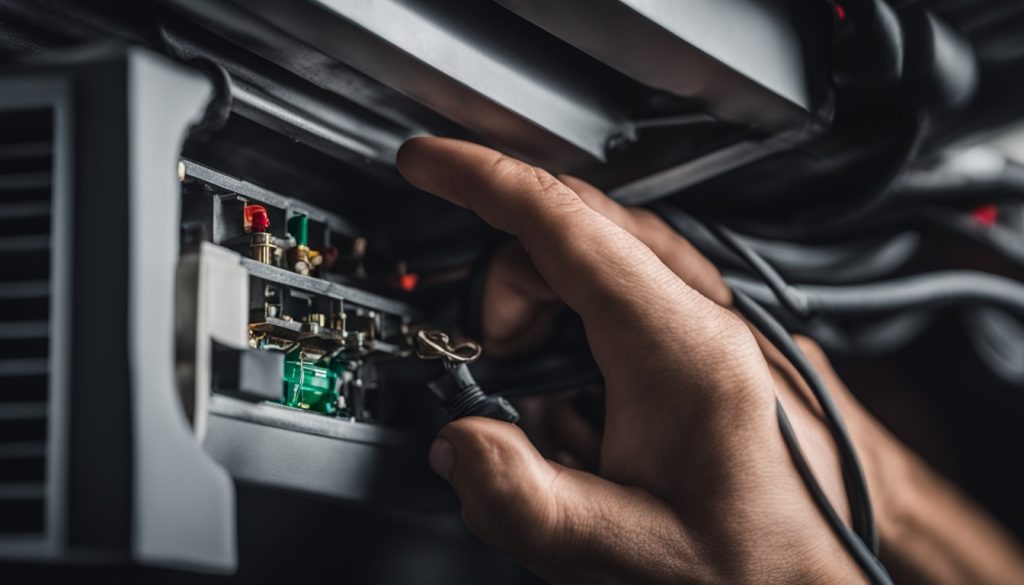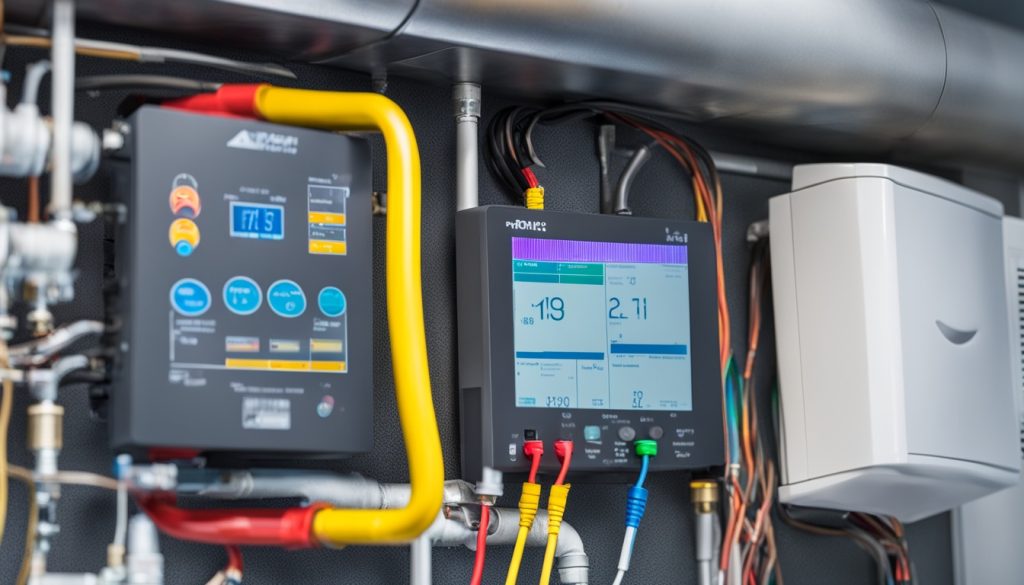Want to make your HVAC system better with sensors? This guide has what you need to know about using sensors to improve your HVAC.
It covers how to pick the right sensors. These sensors are vital for making sure temperature and humidity are right in your HVAC areas. We’ll show you about making and customizing sensors. This includes parts like RTD elements and 4-20mA transmitters for good communication. You’ll also learn why it’s key that sensors are very accurate. Plus, we’ll talk about the best ways to put them in and what that does for commercial places.
Key Takeaways
- Understand essential HVAC sensor technology for optimal system performance.
- Learn the various HVAC sensor types and their specific applications.
- Discover how smart HVAC sensors contribute to energy savings and system efficiency.
- Gain insights into the importance of sensor accuracy in HVAC monitoring.
- Explore effective methods for sensor installation and tuning for better HVAC performance.
- Recognize the benefits of integrating sensors in commercial HVAC settings.
Understanding HVAC Monitoring Sensors
HVAC sensors are very important for heating, ventilation, and air conditioning systems. They help make indoor air better and make systems work well. These sensors are key for keeping the place comfortable and safe.
Why HVAC Sensors Matter
HVAC sensors do a lot in homes and businesses. They keep systems from working too hard, saving energy and money. They also make sure the air inside is good for everyone, which is key for health.
Key Components of HVAC Systems
Many parts work together in HVAC systems. This includes sensors for temperature and humidity. There are also special 4-20mA transmitters for faraway signals.
Top companies like Minco and Belimo make sensors for HVAC. Their parts help systems last longer and do better.
Types of HVAC Monitoring Sensors
There are several HVAC sensor types that each do a special job. They help make HVAC systems work better. These sensors check and keep the air quality just right for comfort and safety, at work or home.

Temperature Sensors
Temperature sensors are key for managing both air and water temps in HVAC setups. They make sure heating and cooling are just right. This is essential for a comfy indoor space. You can find them in different types like thermocouples and thermistors.
Humidity Sensors
Humidity sensors are very important. They control how much moisture is in the air to keep it comfortable. These sensors also stop mold and lower dust mites. They work with other tools to make HVAC systems run better.
Pressure Sensors
Pressure sensors control the right pressure in HVAC units. They spot any issues fast to keep everything working well and safe. Finding leaks or blockages early helps keep the HVAC gear in good shape longer.
Indoor Air Quality Sensors
Indoor air quality (IAQ) sensors check different factors like CO2 and VOCs. They give a complete look at how clean the air is. This helps keep indoor spaces safe and pleasant by finding and fixing air problems quickly.
| Sensor Type | Function | Benefits |
|---|---|---|
| Temperature Sensors | Measure air and water temperatures | Provides optimal heating and cooling |
| Humidity Sensors | Regulate moisture levels | Ensures comfort, prevents mold |
| Pressure Sensors | Maintain system pressure | Prevents leaks, blockages |
| Indoor Air Quality Sensors | Track CO2, humidity, VOCs | Ensures healthy indoor environment |
| Occupancy Sensors | Detect room occupancy | Enhances energy savings |
Occupancy Sensors
Occupancy sensors notice when people are in a room. They help control HVAC gear and lights, saving energy. This smart use of resources helps cut down on waste.
HVAC sensor types for different places. They make sure you can find what you need, whether at home, work, or somewhere else.
Importance of HVAC Monitoring Sensors
HVAC monitoring sensors are crucial. They help achieve high energy efficiency. They maintain the best indoor air quality, and they keep people safe in buildings.
Energy Efficiency
HVAC sensors greatly improve energy use. They keep track of temperature and humidity well. This leads to HVAC systems working better, using less energy, and costing less.
Indoor Air Quality
Having clean indoor air is key. HVAC sensors do this by tracking CO2, humidity, and more. This makes sure the air we breathe indoors is fresh and safe.
Health and Safety
Keeping people healthy indoors is important. HVAC sensors find bad stuff in the air. They help with clean air and prevent sickness from bad air quality.
When paired with top systems like Belimo’s, HVAC sensors help meet rules like ASHRAE 62.1. They make sure business operations are eco-friendly, and they boost how comfy and safe buildings are.
HVAC Sensor Technology
HVAC sensor technology includes many advanced tools for precise control in systems. It goes from making special sensors to improving elements like thermistors. These parts help sensors work right and make HVAC systems run better.
Smart HVAC sensors are becoming more popular for their extra features and flexibility. They use clever math and can talk without wires. This makes systems work better and more dependably.
Making sensors just right for a job is key too. Minco, for example, makes sensors that fit exactly what their customers need. These sensors are carefully set up and tested to make sure they work hard and last in HVAC jobs.
For systems where sensors need to talk far away, they add special units. These units change sensor info into a signal that can travel long distances. Doing this helps sensors work well in big spots or places with lots of electrical noise.

The following table highlights key HVAC sensor technologies and their applications:
| Sensor Technology | Application | Advantages |
|---|---|---|
| Thermistors | Temperature Measurement | High accuracy, cost-effective |
| RTDs | Temperature Control | Stable, precise |
| Thermocouples | Extreme Temperature Monitoring | Wide temperature range, durable |
| Smart Sensors | Real-time HVAC Monitoring | Advanced functionality, remote access |
| Customized Sensors | Specific HVAC Applications | Tailored solutions, high reliability |
Choosing the right HVAC sensor tech is vital for top system performance. Focusing on sensor quality, like with smart sensors or custom solutions, improves HVAC efficiency. This keeps everything running smoothly.
Commercial HVAC Sensors: An Overview
Commercial HVAC sensors are key for heating, ventilation, and air conditioning in business places. It’s important to know the types of sensors and how to install them. This helps make the HVAC system work better.

Types and Uses
HVAC sensors come in many types for different jobs. This includes sensors for temperature, humidity, pressure, indoor air quality (IAQ), and occupancy. Temperature sensors keep air and water at the right levels. Humidity sensors watch moisture, important for comfort. Pressure sensors keep air at the correct levels and show when it needs maintenance. IAQ sensors check for CO2 and harmful particles in the air. Occupancy sensors save energy by adjusting HVAC based on how many people are in the room.
Installation Practices
Installing HVAC sensors correctly is vital for them to work well. You should always follow the maker’s advice to avoid mistakes like putting the sensor in the wrong spot or not calibrating it right. Each kind of sensor has its own needs. For example, don’t put temperature sensors where they get direct sun or drafts. And, put humidity sensors in places that are like the overall room conditions.
Benefits in Commercial Settings
Using HVAC sensors in businesses brings many benefits. It helps manage energy better by watching heating and cooling closely. This cuts down on how much energy is used. Good quality sensors also mean the air is clean, which is great for the health of the people in the building. Sensors are also important for meeting safety rules, ensuring your HVAC system follows the right laws.
| Type of Sensor | Primary Function | Commercial Benefit |
|---|---|---|
| Temperature Sensor | Regulate air and water temperatures | Ensures optimal thermal comfort |
| Humidity Sensor | Control moisture levels | Prevents mold and improves air quality |
| Pressure Sensor | Maintain proper air pressure | Avoids system malfunctions |
| IAQ Sensor | Monitor air quality | Promotes occupant health |
| Occupancy Sensor | Adjust HVAC based on occupancy | Increases energy savings |
How to Install HVAC Sensors Correctly
It’s very important to install HVAC sensors the right way. Doing so helps them work well for a long time. To install them right, you need to plan carefully and use the best methods. This part will teach you the main steps for a good installation and what mistakes to steer clear of.

Preparation Steps
Good installation preparation starts with knowing your HVAC system and what the sensors need. Follow these steps to make everything run smoothly:
- Find out exactly what sensor type you need, like for temperature or humidity.
- Look at what the maker says and follow their directions for putting them in.
- Make sure the sensors will work with your HVAC system’s parts.
- Think about things like how humid or hot it gets and if there might be things in the air that could cause problems.
- Get all the tools and things you need ready before you start. This will make everything go faster.
Common Installation Mistakes
Getting the installation wrong can make your system less efficient and the sensors less accurate. Here’s what people often do wrong and how you can do better:
- Incorrect Placement: Put your sensors where they can take the right measurements. Don’t put them by heat, drafts, or sun.
- Inadequate Wiring: Use the right wires and follow the setup the maker shows. This makes sure the electrical system is strong and readings are correct.
- Improper Calibration: Many sensors need to be set right to work. Make sure to set them up as the maker tells you to. This stops bad readings.
- Neglecting Environmental Considerations: Pick a sensor that can handle where it will be. This keeps it from breaking and working wrong.
- Ignoring Maintenance: Keep your sensors clean and check them often. This will make them last longer and give better readings.
By doing the installation preparation steps well and avoiding known mistakes, your HVAC sensor installation will be a hit. Paying careful attention during setup helps dodge errors. This makes the sensors work better and the whole HVAC system more efficient.
Benefits of HVAC Monitoring Sensors
The benefits of HVAC monitoring sensors do more than just manage temperature. They play a key role in making operations more efficient and keeping indoor spaces healthy. By watching and controlling air quality, HVAC systems keep indoor areas nice. This is important for making sure everyone indoors feels good and is happy.

Improving HVAC efficiency is a top advantage of these sensors. They help by making sure HVAC systems use real-time data to adjust their settings. This way, buildings can stay at the perfect temperature and humidity. And they do this without spending too much energy, which saves money.
These sensors also help save energy. When HVAC systems work better, they don’t need as much power. This means lower bills and less harm to the environment. Thanks to these sensors, managers can find and fix problems quickly. This keeps the whole system running well all the time.
From a green point of view, these sensors really help with indoor environmental quality. They keep the air clean, which stops sickness and allergies. This is key in places like offices, where many people use the HVAC system. Clean air makes sure everyone stays healthy and comfortable.
The following table illustrates the crucial aspects influenced by implementing HVAC monitoring sensors:
| Aspect | Impact |
|---|---|
| Operational Efficiency | Improves by maintaining precise control of temperature and humidity, eliminating wasteful overuse. |
| Energy Savings | Contributes to significant energy consumption reduction, lowering utility bills and carbon emissions. |
| Indoor Environmental Quality | Enhances health and comfort by ensuring air conditions meet stringent standards, preventing health issues. |
| Occupant Satisfaction | Increases by providing a comfortable and healthy indoor environment, improving productivity and well-being. |
Looking closely at the benefits of HVAC monitoring sensors, we see their huge value in improving HVAC efficiency and enhancing indoor environmental quality. Advances in the future will add even more to these benefits. This means better, greener spaces to live and work in.
Optimizing Your HVAC System with Sensors
Getting the best from your HVAC system means using smart sensors well. You should set the sensors right, hook them up with Building Automation Systems, and keep them well adjusted.
Tuning Sensor Settings
Getting the sensor settings correct is key to upping your HVAC game. It makes sure your system reacts quickly to the air around it. This quick response saves energy and makes your equipment last longer. By tweaking the settings often, your system is always set for the weather changes. So, it’s ready for anything the seasons bring.
Integration with BAS
Hooking the sensors up with BAS is a big step in the right direction. It lets your system make decisions based on data. This connection means your HVAC runs more smoothly with less manual effort. Big places like the Empire State Building use this, proving it works well.
Maintenance and Calibration
Keeping your sensors in top shape is vital for a well-tuned HVAC system. They need to be cleaned and checked often, and their calibration must be bang-on. If you skip this, your system won’t perform well and will use more energy. Companies like Carrier and Trane know this, and they strongly recommend keeping the sensors maintained.
| Aspect | Purpose | Outcome |
|---|---|---|
| Sensor Settings Tuning | Refine responsiveness to environmental changes | Enhances system efficiency and longevity |
| BAS Integration | Automate control and monitoring of sensors | Streamlined operations, energy savings |
| Maintenance and Calibration | Regular inspections and adjustments | Ensures sustained accuracy and performance |
Conclusion
The HVAC Monitoring Sensors Guide helps you pick the right sensors for your HVAC system. These sensors, like temperature and humidity ones, are key for making your heating and cooling work well. Using the right sensor tech boosts your HVAC’s performance and keeps the air indoors healthy.
Smart sensors for HVAC make a big difference. They help save energy by managing your system more accurately. This means you can be comfy without using too much energy. These sensors also check the air quality, making sure it’s safe and helping you follow rules for a greener operation.
If you’re a facility manager, good sensor tech is a must for top performance. The advice in this guide can keep your HVAC running smoothly. It’s about more than saving energy. It also helps keep everyone safe and happy indoors, making things efficient, cozy, and secure.





0 Comments